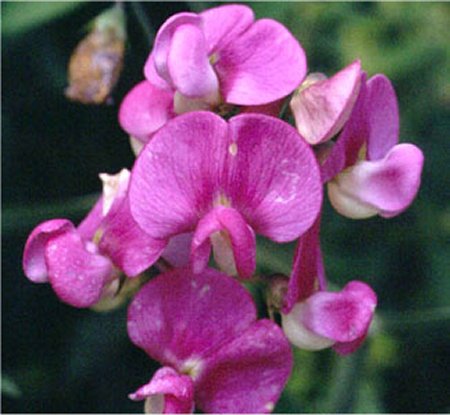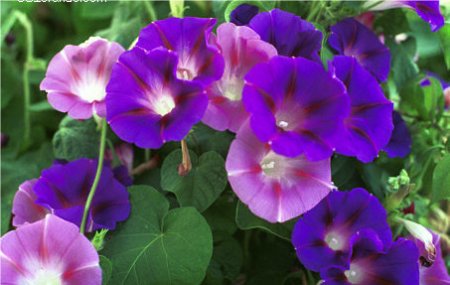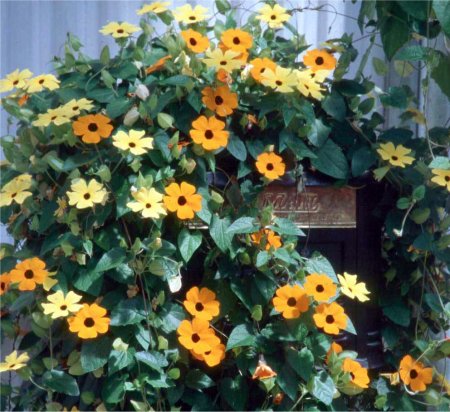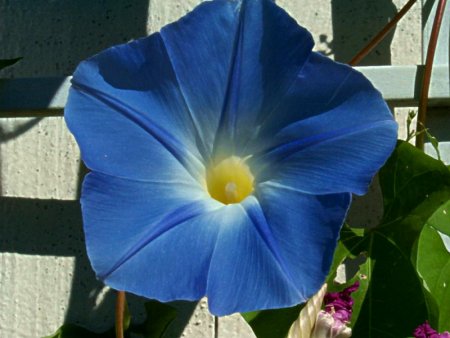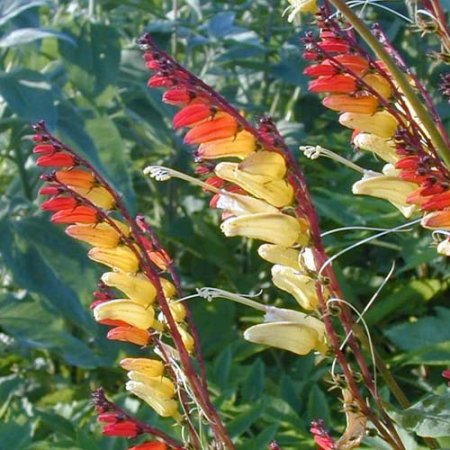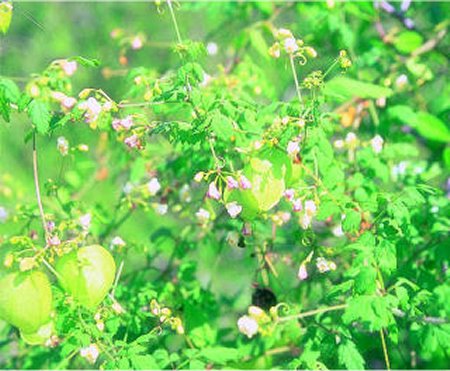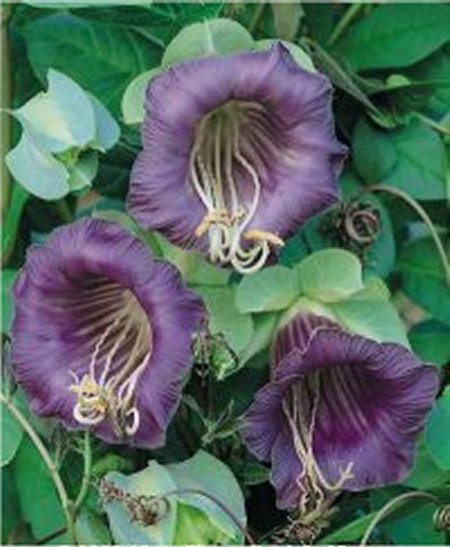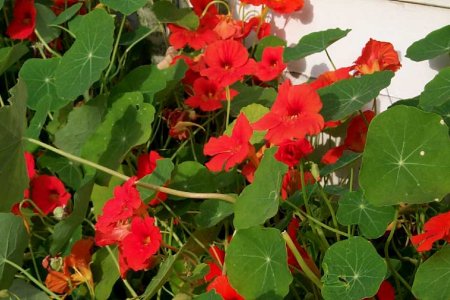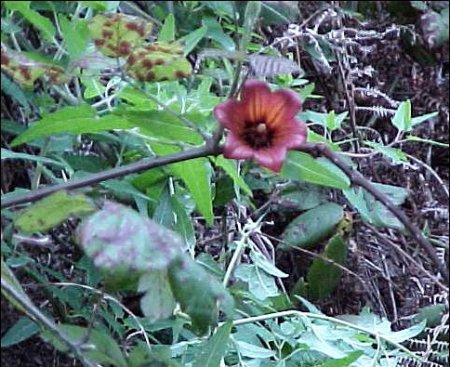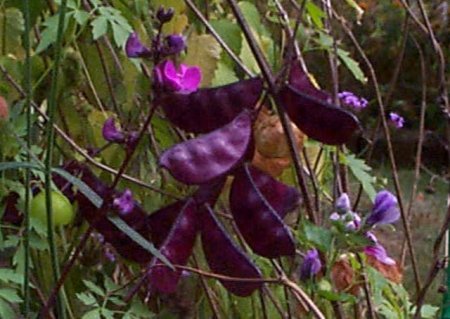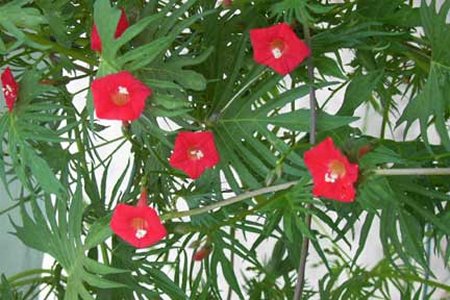
2005 Year in Review
Back to Page two: Other Listing | Back to Year in Review Index
Annual Flowering Vines |
|
Source: Greg Stack 708-720-7520 Home gardeners will find the options for using annual vines are endless, says a University of Illinois Extension horticulture educator. "There's something irresistible about a trellis softened with intense, clove-scented sweet peas," said Greg Stack. "Flowering vines of all sorts can add something special to any garden, no matter how large or small. Whether a living curtain of morning glories to shade a west kitchen window or a white picket fence colored with a bright tumble of black-eyed Susan vines, annual flowering vines can add privacy, disguise harsh landscape features, and just add a touch of color to the garden." Many annual vines, he noted, grow quickly enough to be well on their way to covering a trellis in only a few weeks. By mid-summer, the entire trellis can be covered with foliage and flowers that block the wind, offer some shade, and add a bit of privacy. "Plant your annual vines in the ground in front of a windowpane trellis or a tree, wrapped with flexible trellis," said Stack. "Use them in a planter box with a redwood fan, a pot with a topiary frame, or in a hanging basket or window box. A particularly attractive option if you have limited room is to construct a trellis in a planter box on a deck or balcony." Most annual vines attach themselves to a support with twining stems or tendrils. This allows them to attach easily to a chain link fence, wire, or thin strips of wood. Usually, vines don't cling well to brick or wooden walls. However, they can with some help. Stack said that most annual vines are easy to grow from seed that can be started indoors four to five weeks before they are needed outdoors. "And, because most of them are tender, it is suggested that they be put out after all danger of frost is over and the temperatures remain uniformly warm," said Stack. " Sweet peas are the exception and prefer the cool weather. Vines are also now being found in many garden centers as part of their bedding plant offerings. This saves you the work of having to start seeds and also allows you to put in the 'last minute' plant for that special spot." Stack reviewed some of the vine options gardeners might want to consider. "Sweet pea, an old-fashioned favorite, comes in all sizes, from two-foot tall bushy plants to eight-foot climbers," he said. "The pea blossoms range from scarlet to white to lavender to brilliant bi-colors. Perhaps their best trait is their highly fragrant flowers that also make great cut flowers for indoor decorations. "Sweet peas grow best in full sun during the cooler weather of spring and summer. They like a rich garden soil that retains moisture and can be planted direct-seeded outdoors." It is often helpful to soak the seed overnight to hasten germination, Stack added. Sweet pea varieties that can tolerate the heat of summer are "Old Spice" and "Cupanis Original." There is also a perennial sweat pea called "Pearl" that blooms in June and July and makes a good cut flower. Unfortunately, it is not fragrant but is hardy to zone 3." Morning glories are the logical choice for containers with trellises and for quick growing. "They will grow in almost any soil, preferring poor soils with low fertility," said Stack. "Morning glories prefer full sun but will tolerate very light shade. They are easily started directly in the garden after the soils have warmed up. Because morning glory seed has a hard seed coat, it helps to soak the seed in water overnight or even nick the seed with a nail file before sowing." If trying to fill baskets and mixed containers, the best varieties are in the "Good Morning" series and the "Mini-Bar Rose." Both of these offer a bit more compact habit and the added feature of variegated foliage. "Another star in the morning glory world is 'Sunrise Serenade'," said Stack. "This large plant offers flowers that are two to three inches across and double." Two Morning Glory relatives can also add to the garden: one during the day and one at night. "The moonflower is a very robust vine with large leaves and flowers that look like morning glory but are six inches wide and crystal white," said Stack. "Unlike morning glory that is at its peak during the day, moonflower opens at dusk and stays open all night. They should be planted where their size and very fragrant flowers can be appreciated." Moonflower likes a full sun site and soil that is moist. This vine needs a very long growing season in order to bloom so it should be started indoors from seed or put out in the garden from purchased transplants. "The other relative is Mina lobata. It goes by a lot of names such as Exotic Love and Spanish Flag," Stack said. "This very vigorous vine has fleur-de-li shaped leaves and very unique flowers. Masses of four-to-six-inch long flower spikes are produced that change in color from a soft yellow to a deep rusty red through the summer." Something different is Balloon Vine, also called Love-in-a-Puff. "Gardeners plant this vine not for its flowers, because they are very small, white clusters that go virtually unnoticed," said Stack. "What follows the flowers, though, are whimsical, greenish balloon fruits about the size of very large grapes. These air-filled sacks look like little lanterns on the vine and offer something different. Balloon Vine grows best in full sun in average soil, reaching about 10 to 15 feet. The leaves are very finely cut." Cup-and-Saucer, sometimes called Cathedral Bells, is another vine to consider for uniquely shaped flowers. This vigorous vine produces lush heart-shaped foliage and peculiar reddish-purple cup-shaped flowers that are nestled into light-green saucers. "Nasturtiums are another old-fashioned flower that deserves a place alongside of other vines," said Stack. "Nasturtiums tend not to climb but make a great basket or window-box plant as they trail over the edge of containers. They are great companion plants to plants that grow taller." Red, orange, yellow, and white-spurred flowers are mixed with unique round leaves. These vines are easy to grow from seed and prefer a sunny location in well-drained soil that is not too fertile. Rich soils will encourage abundant foliage and few flowers. The flowers are great when cut and offer a sweet fragrance indoors. "The Canary Climber is another vine to consider, as it is a relative of the nasturtium that does not bear much family resemblance," said Stack. "This vine produces feathery yellow flowers that look like a flock of tropical birds. The bright yellow color is not often seen in vines so it is a welcome addition. The foliage is bright green and deeply lobed. It does prefer the cooler season and so does better in spring and early summer." Black-eyed Susan is a fast-growing, vigorous vine that is equally at home growing up a picket fence or in a hanging basket on the balcony. It is almost better in a basket. The arrowhead-shaped foliage is a blue-green color, and the thin vines hang very well and move gracefully in the wind when used in baskets. "This vine will bloom all summer, colors can range from orange to yellow to white, and all the flowers have very dark centers that contrast well, giving the vine its common name. This vine prefers a full sun location in moist, well-drained soils. Start seeds indoors or buy started plants." The Hyacinth Bean grows to impressive proportions, Stack noted. The attractive blue-green to almost purple leaves are carried on purple stems. All of this provides a good background for the dark purple pea-like flowers. Following the flowers is the second act for the vine--extremely attractive, dark, glossy purple fruit that grows to about three to four inches in length. Hyacinth Bean grows best in full sun and in soils that provide it with plenty of moisture. Sow its seeds directly in the garden when soils start to warm. "For those who want to encourage hummingbirds to the garden, consider planting Cardinal Climber," Stack said. "This vine prefers a full sun site growing to about 8 to 10 feet and producing very fine textured, deeply lobed foliage. The bright red, trumpet-shaped flowers are a calling card for hummingbirds. Soak seeds overnight prior to seeding in the garden." Stack said when planning to use annual vines, gardeners should keep in mind that combinations can be very attractive. “Combine old-fashioned Sweet Peas with Morning Glories to cover the upper and lower parts of a trellis,” he said. “Canary Vine combined with Hyacinth Bean makes an eye-catching display.” by Editor, theCity1.com |
|
Copyright © 2005 TheCity1.com.
All rights reserved
